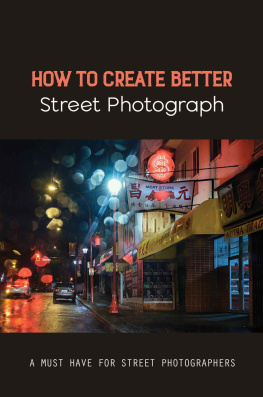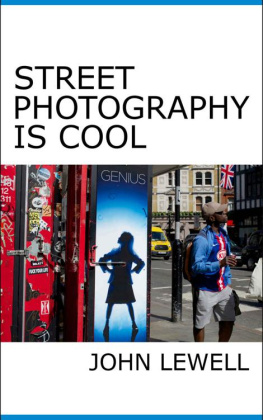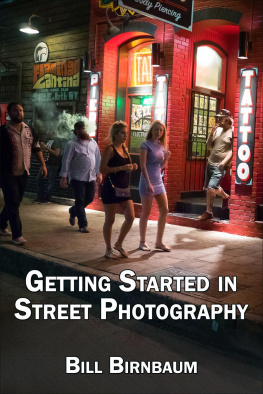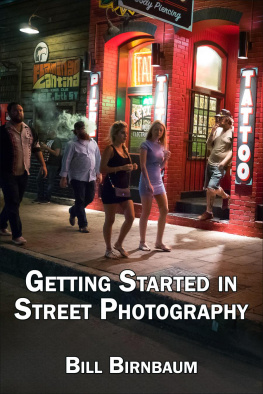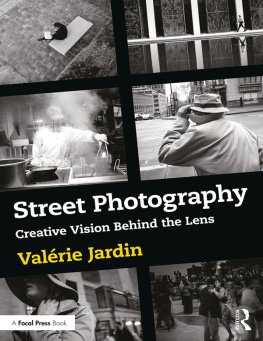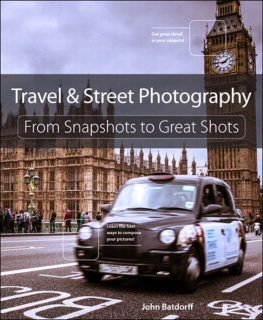
Street Photography 55 Ways to Capture Better Shots of Ordinary Life
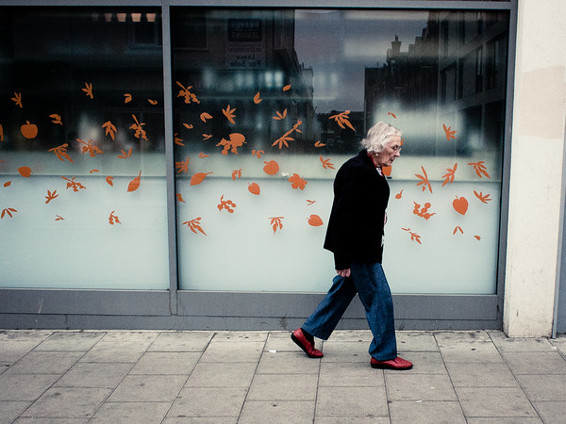
by Eric Kim With contributions from:
Ludmilla Morais
Blake Andrews
Thomas Leuthard
Kramer ONeill
STREET PHOTOGRAPHY by Eric Kim
erickimphotography.com
Text 2015 DEXT AB.
Images Eric Kim, except where otherwise noted; see rights page for more information.
All rights reserved.
No part of this book may be reproduced in any formwhether written, electronic, recorded, or photocopiedwithout written permission of the publisher.
Although every precaution has been taken to verify the accuracy of the information contained herein, the author and publisher assume no responsibility for any errors or omissions. No liability is assumed for damages that may result from the use of information contained within.
Published by DEXT in Stockholm & New York. On the web at DEXT.mobi. Contact us at sales@DEXT.mobi.
Editor: Johan Steensland, Cemark
Consulting Editor: Julie Mazur Tribe
Proofreader: Alison Hagge
Cover Design & Layout: Tobias Hagberg
Kim, Eric, 1988
Library of Congress Catalog Number: 2013957591
Print edition ISBN: 9789186841546
E-pub edition ISBN: 9789186841621
Kindle edition ISBN: 9789186841560
PDF edition ISBN: 9789186841638
First edition
E-book authoring by Ionfox AB
Contents
The biggest challenge for budding street photographers is to overcome their fear of shooting in the streets. Use the tips in this chapter to learn how to conquer that fear.
One great thing about street photography is that it transcends technology and gear hype. Bring a small and simple camera with a wide-angle lens, and you will be fine.
The decisive moment is a term coined by street photography pioneer Henri Cartier-Bresson. This chapter will explain what it is all about, and how to capture that split second of genius and inspiration.
Use the techniques in this chapter to challenge yourself as a storyteller, make the most of your equipment, and energize yourself when you feel uninspired.
Learn how to blend into the environment and use your personality to make subjects feel more comfortable.
Your view of the world is unique, as are your personality and aesthetic sensibility. Here are some ideas for finding your personal style.
Decisions, decisions, decisions. This chapter will help you decide how to crop, when to work in color versus black-and-white, how to deal with imperfections, and how to compose your shots.
As a street photographer, you will get to meet a lot of people, both in real life and virtually. Here are some tips to make the most of your online presence.
Foreword

I have had the honor to accompany Eric Kim throughout his photographic journeyfrom his Los Angelesbased portfolio and countless photography initiatives, to his now global photography community, workshops, and travels. Eric has always been a teacher and lifelong learner at heart. When he realized how limited the resources were for aspiring photographers, he created a lively blog for discussion and sharing his knowledge. By doing that, he turned a solitary and competitive art form into a community of learners and teachers such as himself. Erics exuberant and giving personality is inextricably woven into his approach to photography and teaching intentional, present, and honest. Eric never intended to be a professional artist or blogger. He simply does what he loves! And he strongly believes in sharing that passion and experience with others. This book demonstrates not only Erics extensive knowledge in street photography, but also his firm belief that with the right tools and dedication, you, too, can further develop your photographic abilities.
Cindy Nguyen,
Eric Kims First Student
Introduction
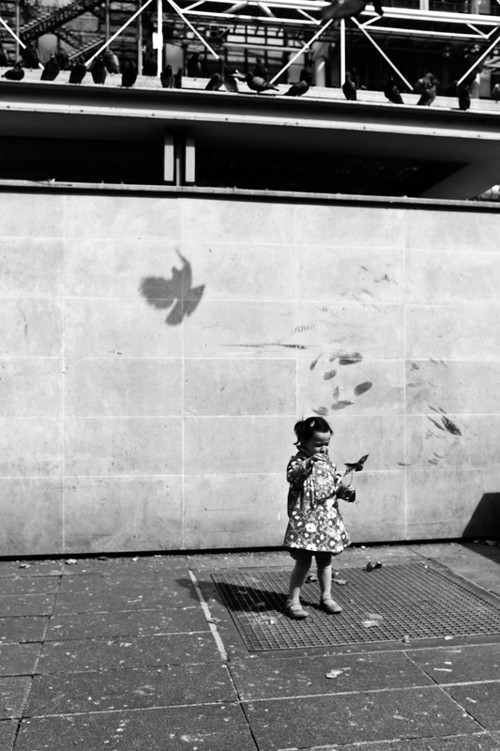
I remember when I shot my first street photograph. It was a sunny afternoon in Los Angeles. I had just finished class and was waiting for the bus, camera in hand. Suddenly, I noticed a young man with round spectacles leaning against a pole, casually reading a book. In that split second I was overwhelmed by a thought: I had to take a photo of him! However, the mere thought of taking the mans photograph without his permission scared me. My heart was pounding. I slowly brought the camera to my eye.
And that was when it happened: the magic! The man shot a glance at me, and I clicked the shutter. Adrenaline flowing, I looked at my LCD screen and knew I had got the shot. I had captured something remarkable. It was this great moment that introduced me to street photography. This momentthis simple photograph unearthed in me a passion for documenting the unstaged beauty, intricacies, and humor of everyday life.
People often ask me, Eric, what exactly is street photography? Simply put, it is capturing the beauty in the mundane, and ordinary people doing everyday things. It is capturing a slice of life, unedited and raw. It is an affirmation of the world around us and all the things we are often too busy to notice.
If you have ever been interested in street photography or wanted to learn how to shoot images of strangers in public, this book is for you.
Eric Kim
If your photos arent good enough, then youre not close enough.Robert Capa
Chapter 1: A first taste

The biggest challenge for budding street photographers is to overcome their fear of shooting in the streets. Use the tips in this chapter to learn how to conquer that fear.
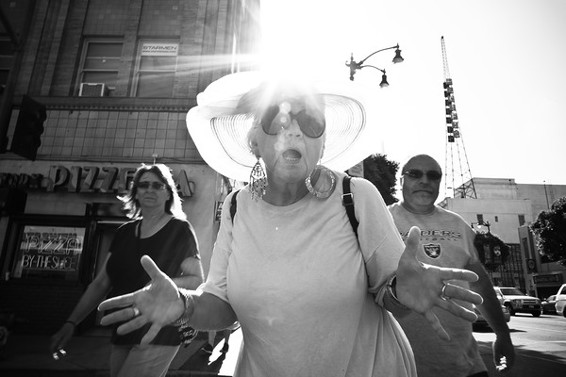
1. Get close! Now take two steps closer.
Robert Capa, the famous twentieth-century war photographer and co-founder of the international photo agency Magnum, once said, If your photos arent good enough, youre not close enough. This is especially true for street photography, as getting close to your subject is an important consideration if you want to capture a compelling image.
Whether out of respect for their subjects, laziness, or shyness, photographers often try to keep their distance. As a consequence, their images often lack feeling and soul.
By getting close to your subject you create an image that feels more intimate. You make the viewer feel that he or she is there. Rather than being a voyeur looking in at the scene, the viewer becomes an active participant.
By getting physically close to your subject, you also get emotionally close. You are able to experience your subjects perspective, which allows you to connect with him or her on a personal level and makes you feel part of the action. By getting closer, you fill the frame with more energy and action. Presence cannot be registered from a distance; it must be up close and personal.
Type in to see a YouTube video of Eric shooting in Venice Beach, California
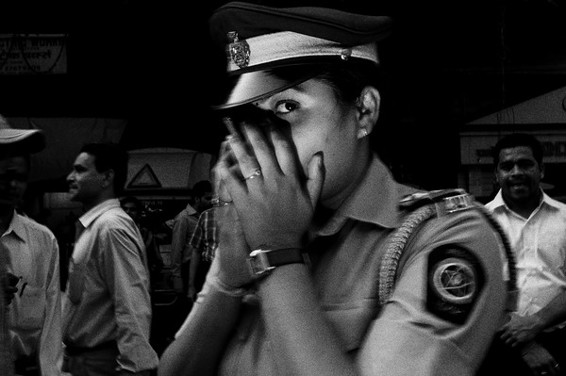
2. Show respect
Street photography should be done without permission, candidly, and from the heart. However, shooting pictures of people in public raises delicate questions about showing respect for your art form, and your subjects. Remind yourself of the why that is, why you are shooting in the streets. Respect demands that your intention should be to capture the beauty of everyday life. For example, think twice before shooting photos of homeless people or others struggling in life. Do you truly empathize with their situation and want to shed light to it? Or are you taking photos to exploit their misery and to call yourself an artist? Its all about the why .
Next page


